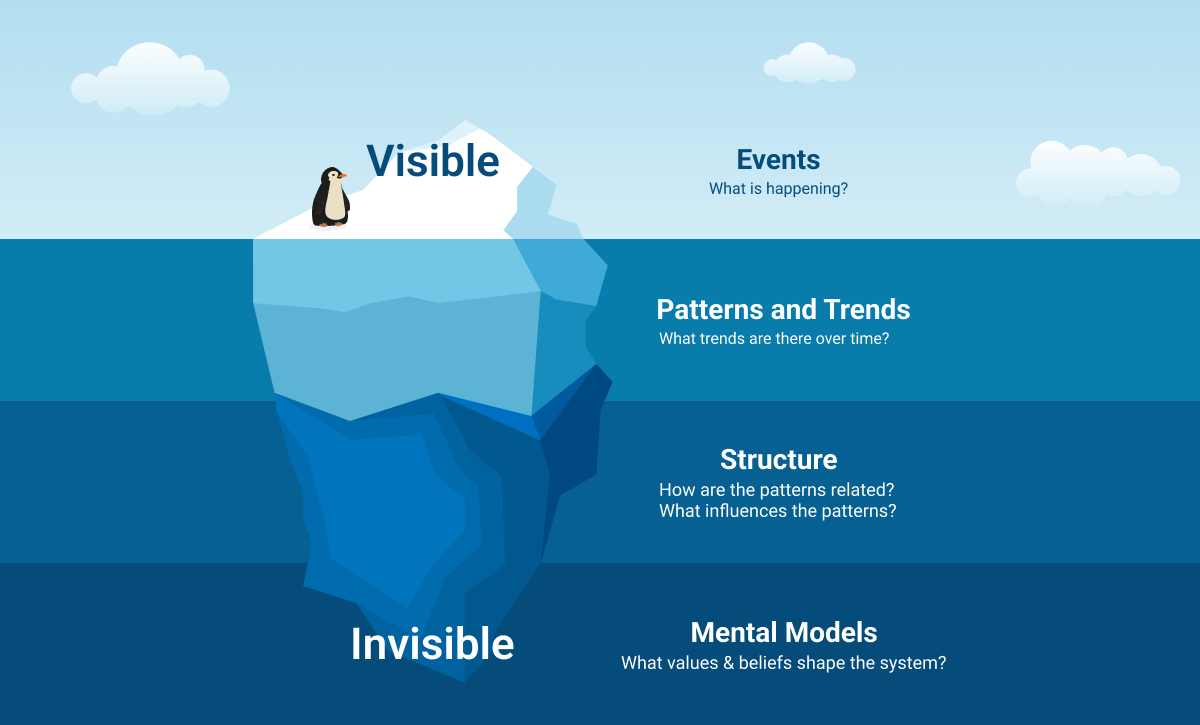
Exploring the Power of Systems Thinking in Product Design
Ever notice how every new project feels like navigating uncharted territory? In many ways, it is. Product design means working within a web of relationships where every decision creates ripple effects, both visible and hidden. To make sense of that complexity, we rely on a powerful approach: systems thinking.

Systems thinking is a way to understand problems and design better solutions. It helps us see everything as part of a connected system rather than separate pieces. By noticing how different parts interact and influence the whole, we can make smarter choices. Systems thinking is a mindset that helps us explore complexity and uncover how different pieces shape the decisions we make.
Uncovering the Depths of Systems Thinking
Systems thinking helps designers understand what lies beneath the surface. Designers often reference the iceberg model to illustrate this. What is visible above the water is only a fraction of the intricate network below. The model highlights hidden structures, patterns, relationships, and feedback loops that exist within any system. These elements are often unseen, yet they influence behavior. By looking deeper and adopting systems thinking, we unlock the potential to craft more effective solutions for products and systems alike.

Practical Applications of Systems Thinking in Your Product Design Workflow
Designing meaningful products requires understanding how every part of a system interacts. Systems thinking gives designers that perspective, helping them anticipate outcomes and create experiences that work in the real world. Below are three examples that show systems thinking in action.
Feedback Loops: How Small Changes Ripple Through
Feedback loops explain how actions in a system trigger reactions that either amplify or stabilize change. Imagine a coffee shop loyalty program:
- Positive feedback: The more rewards customers earn, the more they buy, which accelerates growth.
- Negative feedback: If rewards become too generous, costs rise and the program adjusts to maintain balance.
In product design, feedback loops reveal why small changes can have outsized effects. A slight adjustment to a recommendation algorithm can dramatically shift user behavior. By applying this systemic perspective, designers can anticipate these chain reactions and design for stability instead of reacting to unintended consequences.
Time Delays: The Hidden Lag
Time delays show how long it takes for one part of a system to respond to another. They often go unnoticed but can shape user experience.
- Press a button on a TV remote and wait for the channel to change. That pause is a delay.
- In digital products, delays occur when backend processes take time to update, such as syncing data across devices.
Delays matter because they influence perception. A slow-loading page can feel broken even when it is functioning correctly. Designers who adopt a systems thinking approach can anticipate these delays and use strategies like progress indicators, skeleton screens, or predictive loading to create smoother, more predictable experiences.
Emergent Properties: More Than the Sum of Parts
Emergent properties are outcomes that arise when individual parts of a system interact in ways that produce results greater than the sum of their parts. They emerge from relationships within the system.
Think of a flock of birds moving in perfect formation. Each bird follows simple rules—maintain distance, match speed—but together they create a coordinated pattern that no single bird controls.
In product design, emergent properties appear in powerful ways:
- Social platforms: A simple “like” button combined with algorithms and user behavior can create viral trends or echo chambers.
- E-commerce: Personalized recommendations, inventory systems, and user reviews interact to create shopping experiences that feel seamless.
- Collaboration tools: Comments, notifications, and version history combine to form workflows that teams adopt naturally, even if designers did not plan them.
Understanding emergent properties helps designers anticipate unintended consequences and harness positive patterns. Instead of designing isolated features, we design for interactions because that is where the real product experience lives.
The Power of Systems Thinking in Product Design
Systems thinking means understanding how every decision, feature, and interaction connects within a larger ecosystem. Products live in networks of users, technologies, and business goals. When designers embrace this perspective, they can anticipate ripple effects, reduce complexity, and create experiences that feel seamless.
Applying systems thinking means looking beyond individual screens or features. It means asking how changes influence user behavior, how processes interact over time, and how small details combine to create emergent patterns. This approach helps teams design products that are resilient and adaptable.
The result is thoughtful, effective design that works in the real world. By understanding systems, we move from building isolated solutions to crafting ecosystems that deliver lasting value. Let us design with clarity, purpose, and connection.
Let’s build awesome things together.
Our approach to Product Design & UX is holistic, integrating business, tech, user needs, and market demands.